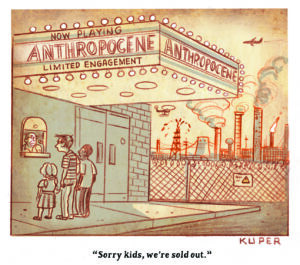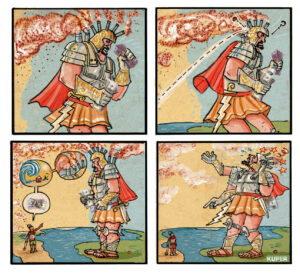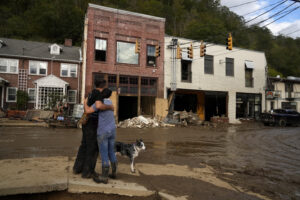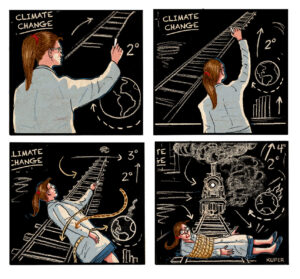For the Midwest, There’s No Easy Way Out of This Year’s Drought
Sporadic, intense rain events and soil conditions affect the region’s ability to recover from hot and dry weather. A farmer stands in a crop field in Jasper, Missouri. Most of the Midwest is in drought after a prolonged dry spell in the spring. Credit: Luke Runyon / Harvest Public Media.
A farmer stands in a crop field in Jasper, Missouri. Most of the Midwest is in drought after a prolonged dry spell in the spring. Credit: Luke Runyon / Harvest Public Media.
A hot summer and dry spring have brought drought to a large part of the Midwest. The lack of moisture has far-reaching implications, including on agriculture and water levels on the country’s largest rivers.
“Rain is essential — it is where drought starts and ends,” said Illinois State Climatologist Trent Ford. “As we were going into drought from April through June, we just weren’t getting rain.”
The situation highlights the complexity of exiting drought when a state or region can slip into it relatively easily, Ford said. Rainfall across parts of the Midwest in recent weeks is helpful, but it may not be enough to alleviate the dryness, he said.
One complicating factor is the changing climate, which is causing increasingly sporadic rain events that can drop inches of rain in only a few hours when they do come, said Jason Knouft, a biology professor at St. Louis University who studies the impacts of human activities on freshwater resources.
Soil conditions also play an important role in drought relief.
“Those seem to be more common than these long soaking rains,” he said. “When we get these intense rainfall events, you’ve got a lot of water hitting the landscape really quickly.”
The Northeast — especially Vermont — and parts of western Kentucky both experienced intense rain events in July, which spurred significant flooding. The dry ground cannot absorb all the water that comes in these kinds of storms, Knouft said.
“When you dump a huge amount of water onto a surface, even if you’re dumping it onto soil, there’s only so much the soil can absorb,” he said. The rest runs off, meaning a local watershed is capturing only a fraction of all of the rain that fell, Ford said. He points to the St. Louis region as an example, which is close to the anniversary of historic rainfall last year.
The nine inches that fell in late July helped propel last summer to rank as the sixth wettest of all time for St. Louis, even though the region was quite dry beforehand, Ford explained. “The majority runs off. It’s down the Mississippi, down to the Gulf. It’s gone” he said.
Soil conditions also play an important role in drought relief. But what’s growing in the ground isn’t always the best at capturing water, Knouft said.
“We’ve got these row crops that don’t have particularly deep roots,” he said. “So when the rain falls, there’s not as much stability in the soil.” The water just washes the soil away.
Cover crops, when a field isn’t in active agricultural production, can help soils retain more water from rain, Knouft said. Perennial crops aid, too, because their roots are deeper and maintain the soil integrity, which in turn makes it easier to hold onto water, he added.
Various crops also respond to drought differently. Corn and soybeans can bounce back from early season dryness if given some rain, though current forecasts have some worried about severe crop damage. Other crops aren’t as resilient on an annual basis, Ford said.
“We’ve seen more widespread impacts to pasture and hay conditions,” he said, explaining that grasses often stop producing when they are dry.
Those pasture lands may not return to productivity until next year, Ford added, which highlights how complicated it can be for an area to get out of drought.
He said if rainfall increases to normal amounts, the Midwest will see relief for corn and soybean crops this season. But it takes much longer for groundwater reserves to recover from being drawn down.
This year’s drought is also raising concern about low flows on rivers like the Mississippi and Missouri.
The drought conditions are affecting the Mississippi’s levels because there’s less overall water in the ground that contributes to the base flow in the river and its tributaries.
“It’s really the third summer in a row where we’ve had some sort of classification of drought in the majority of the basin,” said Mike Welvaert, service coordination hydrologist for the North Central River Forecast Center. “Most of the reservoirs, lakes, and some of the smaller rivers and such just don’t have that much water in them.”
Water is trickling out of those resources, but only the minimum to sustain river flows, Welvaert said. That’s been the case already for weeks, he explained. Already some states have issued water restrictions because of the prolonged dryness, Welvaert added.
“The fact that we’re so low, so early in the year,” Welvaert said, “that is where our concern lies.”
It comes ahead of the Mississippi River’s natural low point of the year in the fall.
“It’s the lowest time for rivers because it’s the cumulative effect of all the evaporation that happened in the summertime,” Ford said, in addition to surface water being used for irrigation of lawns and agriculture.
The drought conditions are affecting the Mississippi’s levels because there’s less overall water in the ground that contributes to the base flow in the river and its tributaries, Welvaert said.
In more normal springs and summers, precipitation falls frequently and percolates into the ground, sometimes deep into the soil, he explained. It can then return to the surface as a spring or another source of groundwater, Welvaert added.
Both Welvaert and Ford stressed that the Mississippi’s fate for this year isn’t sealed yet.
“That’s how most of the rivers maintain their certain level of water even when it’s dry out,” he said. “They’re getting water from underground sources.”
But the dryness across the upper Midwest and Great Plains means the top layer of soil is soaking up rain when it does fall, Welvaert said.
“We just don’t have any additional water to send downstream even when it does rain,” he said. “The same thing is happening in the Missouri Basin.”
Both Welvaert and Ford stressed that the Mississippi’s fate for this year isn’t sealed yet. The weather patterns can still shift and produce a string of thunderstorms that drop consistent rain across the entire basin, Welvaert said.
“We really need more prolonged rainfall, but we can keep it at bay if we get the right amount of rain in the right places at the right times,” Welvaert said. “We’re still hoping for some of that to happen.”
Your support is crucial...As we navigate an uncertain 2025, with a new administration questioning press freedoms, the risks are clear: our ability to report freely is under threat.
Your tax-deductible donation enables us to dig deeper, delivering fearless investigative reporting and analysis that exposes the reality beneath the headlines — without compromise.
Now is the time to take action. Stand with our courageous journalists. Donate today to protect a free press, uphold democracy and uncover the stories that need to be told.






You need to be a supporter to comment.
There are currently no responses to this article.
Be the first to respond.